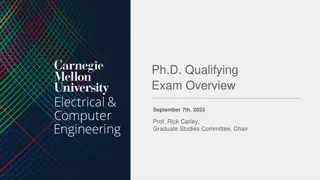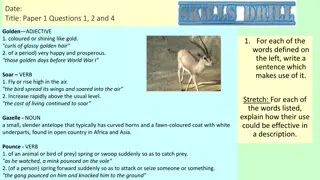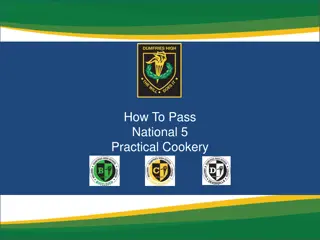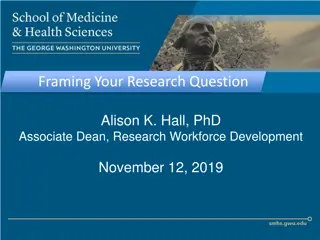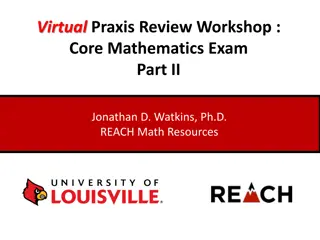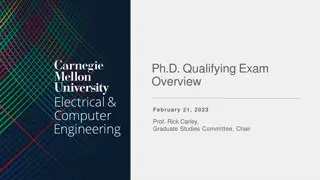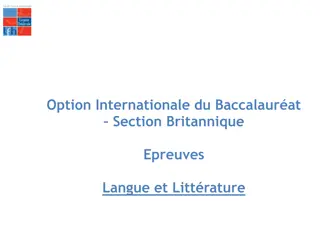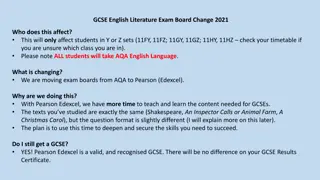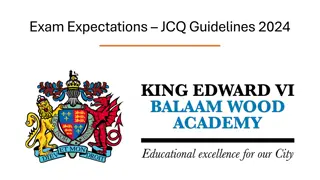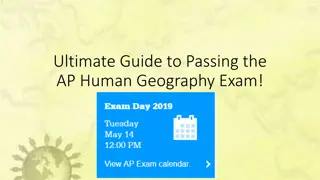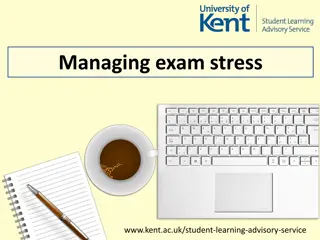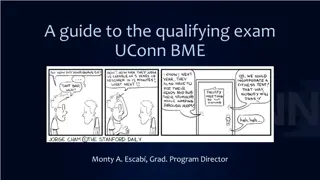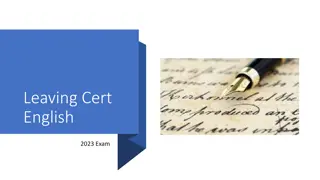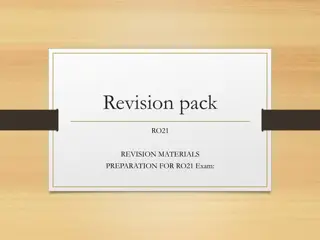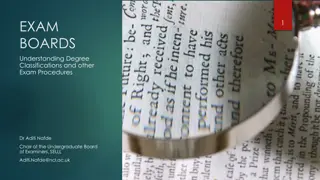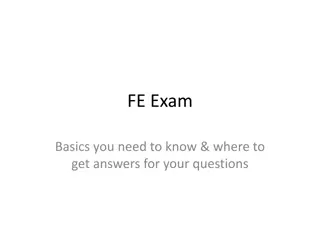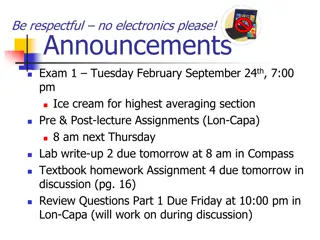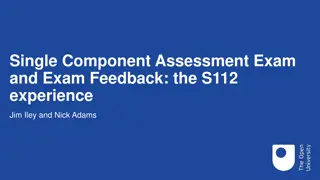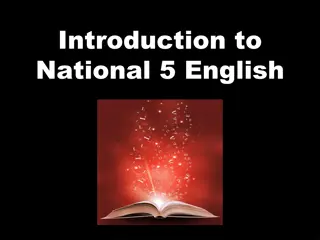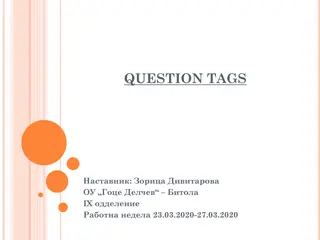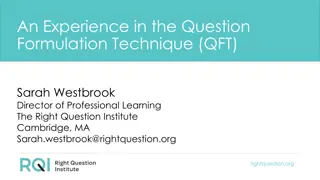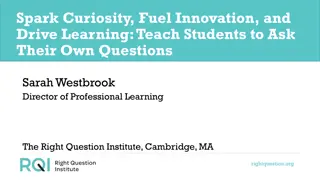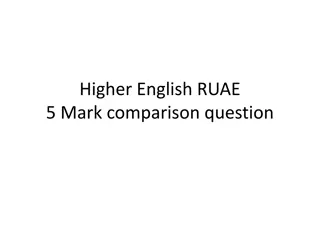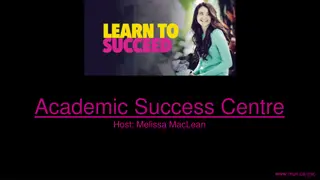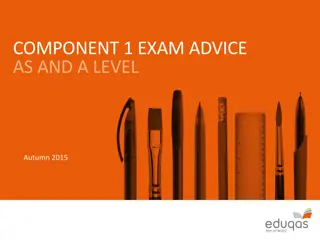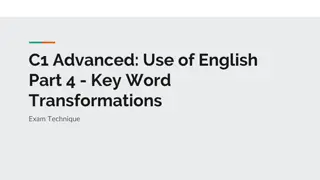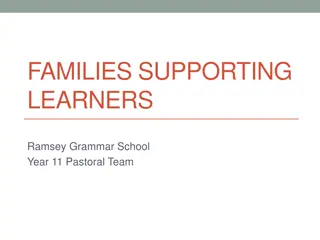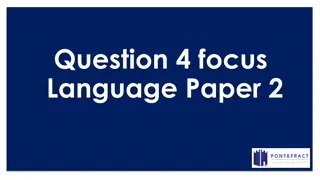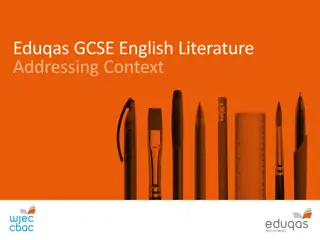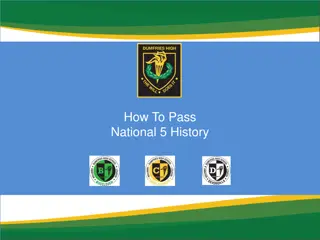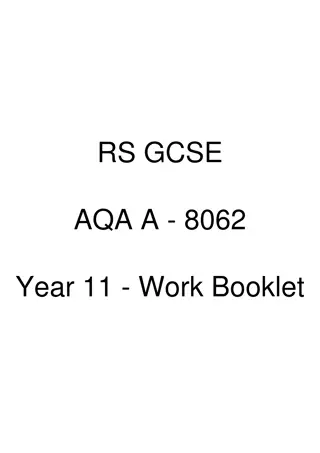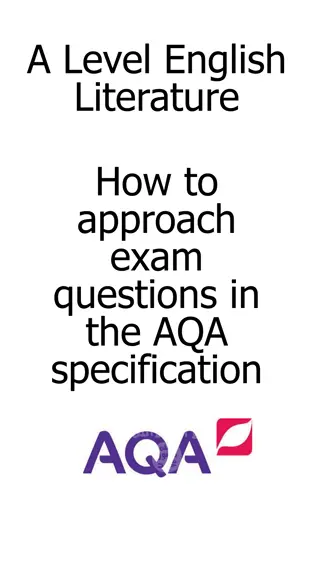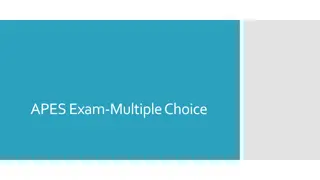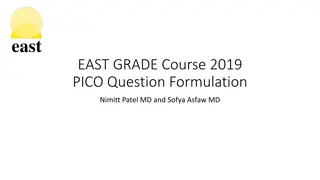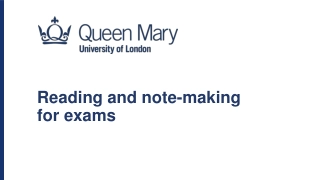Effective Exam Question Analysis
This content provides examples of words like "gloomy," "amiable," "scholar," "sensation," and "meticulous" with sentences to explain their meanings. It also includes questions related to prediction of exam questions based on extracts and creating questions to analyze descriptions in a text.
Download Presentation

Please find below an Image/Link to download the presentation.
The content on the website is provided AS IS for your information and personal use only. It may not be sold, licensed, or shared on other websites without obtaining consent from the author. Download presentation by click this link. If you encounter any issues during the download, it is possible that the publisher has removed the file from their server.
E N D
Presentation Transcript
Date: Title: Paper 1 Questions 1, 2 and 4 gloomy ADJECTIVE causing or feeling depression or despondency. "gloomy forecasts about the economy 1. For each of the words defined on the left, write a sentence which makes use of it. Amiable ADJECTIVE having or displaying a friendly and pleasant manner. "the amiable young man greeted me enthusiastically Scholar - NOUN a person who is highly educated or has an aptitude for study. "Mr Bell declares himself no scholar Stretch: For each of the words listed, explain how their use could be effective in a description. Sensation - NOUN a widespread reaction of interest and excitement. "his arrest for poisoning caused a sensation Meticulous ADJECTIVE showing great attention to detail; very careful and precise. "the designs are hand-glazed with meticulous care"
Read the extract carefully. Predict the exam questions. Q2 always asks you to analyse how something is described. After read the extract, what do you think this question will focus on? Which section of the text? Why? Q4 always involves a statement about the extract. After reading the extract, what do you think this will focus on? Stretch: Write your own example question 2 and question 4 based on the extract.
Q2. Look in detail at this extract from lines 5 to 20 of the Source. (Extract in paper.) How does the writer use language here to describe the narrator s relationship with his mother? [8 marks] Q4. Focus this part of your answer on the second part of the Source from line 18 to the end. A student, having read this section of the text, said: The description is so vivid that the character of the mother really seems to come to life. To what extent do you agree? [20 marks]
Q1. Read again the first part of the Source from lines 1 to 6. List four things from this part of the text about the narrator. A B C D [4 marks]
Q1. Read again the first part of the Source from lines 1 to 6. List four things from this part of the text about the narrator. A B C D [4 marks] Indicative content; students may include: His mother died when he was young He thinks that his life would be different if his mother had not died He thinks that everything that has happened to him since his mother s death is his own fault He has never met anyone who loved him as much as his mother did Or any other valid responses you are able to verify by checking the Source.
Q2. Look in detail at this extract from lines 5 to 20 of the Source. (Extract in paper.) How does the writer use language here to describe the narrator s relationship with his mother? [8 marks] Common mistakes: Rather than pick three good quotes , track the entire extract and try to discuss as more use of language in detail. You must use subject terminology! The writer employs to describe The writer says suggesting The writer also says implying This is a powerful image which conveys Spending too long on the question/ not enough time Not tracking the extract and identifying and discussing as many examples as possible Not discussing the impact of word choice in enough detail Not identifying language techniques accurately Not discussing the effects or not explaining quotations in enough detail Not making perceptive interpretations Not using embedded quotations
Q2 [AO2 - language] Look in detail at this extract from lines 5 to 20 of the source: Her death the dividing mark: Before and After. And though it s a bleak thing to admit all these years later, still I ve never met anyone who made me feel loved the way she did. Everything came alive in her company; she cast a charmed theatrical light about her so that to see anything through her eyes was to see it in brighter colours than ordinary I remember a few weeks before she died, eating a late supper with her in an Italian restaurant down in the Village, and how she grasped my sleeve at the sudden, almost painful loveliness of a birthday cake with lit candles being carried in procession from the kitchen, faint circle of light wavering in across the dark ceiling and then the cake set down to blaze amidst the family, beatifying* an old lady s face, smiles all round, waiters stepping away with their hands behind their backs just an ordinary birthday dinner you might see anywhere in an inexpensive downtown restaurant, and I m sure I wouldn t even remember it had she not died so soon after, but I thought about it again and again after her death and indeed I ll probably think about it all my life: that candlelit circle, a tableau vivant* of the daily, commonplace happiness that was lost when I lost her. She was beautiful, too. That s almost secondary; but still, she was. When she came to New York fresh from Kansas, she worked part-time as a model though she was too uneasy in front of the camera to be very good at it; whatever she had, it didn t translate to film. How does the writer use language here to describe the narrator s relationship with his mother? You could include the writer s choice of: words and phrases language features and techniques sentence forms. [8 marks]
The writer uses to describe the narrators relationship with his mother quote By using the writer suggests Also, the use of implies Furthermore, by using the writer indicates Q2. Look in detail at this extract from lines 5 to 20 of the source: How does the writer use language here to describe the narrator s relationship with his mother? You could include the writer s choice of: words and phrases language features and techniques sentence forms. The writer also uses to describe the Finally, the writer uses to describe
What are the key words in the question/statement? Q4. Focus this part of your answer on the second part of the Source from line 18 to the end. A student, having read this section of the text, said: The description is so vivid that the character of the mother really seems to come to life. What do the examiners want to see? 1. Write about the effect on you/the reader 2. Show understanding of the writer s methods (language and structure) 3. Use subject terminology 4. Use textual references/quotes 5. Respond to the focus of the question 6. Give your personal response to the statement and explain how why you agree/disagree with it 7. Evaluate critically and in detail the effect on you the reader with perceptive comments To what extent do you agree? [20 marks] The writer employs . To show The writer says suggesting The writer also says implying This is a powerful image which conveys
I agree with the statement, its clear from the text that Q4. Focus this part of your answer on the second part of the Source from line 18 to the end. The writer uses to describe the mother quote By using the writer suggests Also, the use of implies Furthermore, by using the writer indicates A student, having read this section of the text, said: The description is so vivid that the character of the mother really seems to come to life. The writer also uses to describe the To what extent do you agree? [20 marks] references to the text. Finally, the writer uses to describe
What knowledge have you learnt today? What skills have you learnt/developed today? How has your previous learning helped you today?


